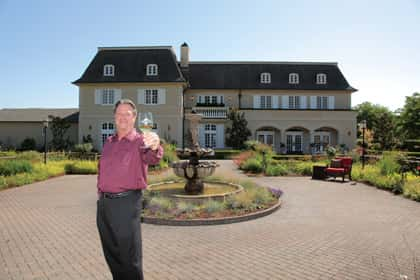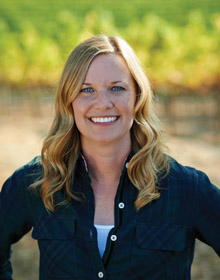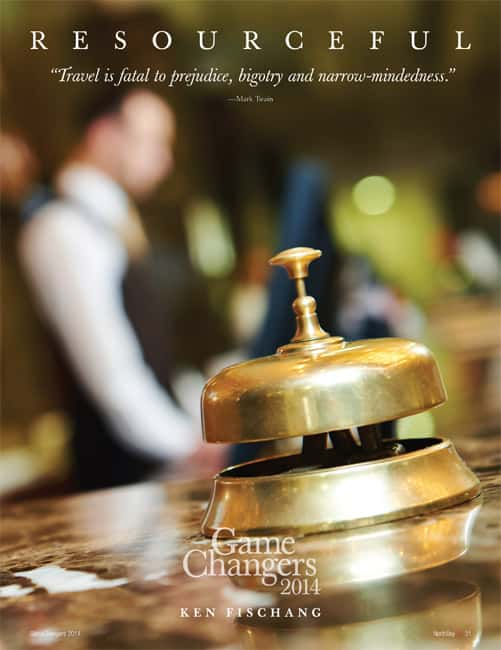“Travel is fatal to prejudice, bigotry and narrow-mindedness.” —Mark Twain
Ken Fischang may be the ultimate Sonoma County tourist. He’s visited every single winery of the hundreds open to the public (and many more that aren’t). He’s hiked and smelled the wildflowers in the county’s 50 regional parks—state parks, too—and is well into his current goal of strolling through its 250-plus art galleries.
Why does he do it? Because Fischang loves his job as president/CEO of Sonoma County Tourism (SCT), the county’s destination marketing organization (DMO). A self-professed overachiever, he succinctly sums up his reason for thoroughly exploring Sonoma County’s diverse 1,768-square-mile landscape: “How can I sell something to visitors that I haven’t visited myself?”
As Fischang tells it, “It took four years and a lot of spitting” to taste at more than 600 wineries. In his first year on the job, he also visited nearly 300 hotels, motels, bed-and-breakfast inns, vacation home rentals and campgrounds countywide. “Keeping up with new tourism-focused businesses that open is part of the job,” he adds.
“Someone who wants to spend his free time also doing what he does for work, well, that’s a really dedicated and passionate individual,” says Karissa Kruse, president of Sonoma County Winegrowers, about Fischang. “Personally going to every winery: That exemplifies Ken. He’s all about discovery and exploration and bringing as many people along for the ride as he can. He’s as excited about this community and tourism as you are as the visitor. You want that energy, and Ken has a lot of energy.”
 Food-and-wine guy
Food-and-wine guy
Fischang, 55, grew up in Massachusetts, New Hampshire and Indiana. In his youth, he was active in competitive sports—basketball, ice skating and roller skating. He graduated from high school in Indiana and earned his bachelor’s degree in restaurant and hotel management from Purdue University. He began his hospitality career in 1978 with Hyatt Hotels and worked at Hyatt properties in Chicago, Long Beach and San Francisco. Then he spent more than a decade in Palm Springs as director of catering and convention services at two major resorts before joining the management team that opened the Palm Springs Convention Center.
In that capacity, Fischang worked for the city of Palm Springs when Sonny Bono was mayor. “We had an advertising campaign where Sonny dressed up as Uncle Sam, and we’d take him with us to trade shows,” he recalls. “That was a really fun time in my career.”
After Palm Springs, Fischang joined the Pasadena Convention and Visitors Bureau, where he developed and managed the marketing plan for that city, among other achievements. He came to Sonoma County in 2005 following a three-year stint as executive director of the Kalamazoo County (Michigan) Convention and Visitors Bureau and vice president of marketing and tourism for the Kalamazoo Regional Chamber of Commerce.
“My goal was to become the president and CEO of a national destination marketing organization, and Pasadena was my springboard to Kalamazoo,” he says. “I rebuilt the whole organization in Kalamazoo from the ground up. When I left, the chamber and the CVB had more than 3,000 members and a $4.2 million budget, which was pretty substantial. That helped prepare me for the job in Sonoma County. Plus, I’ve always been a food-and-wine guy.”
Bringing the wine drinkers
 Fischang stepped into a challenging and dynamic situation in Sonoma County, says Ben Stone, executive director of the county’s Economic Development Board (EDB). Stone explains that, when Fischang arrived to take the helm, the agency had only recently been spun off from a successful seven-year incubation period, through the EDB, into a standalone nonprofit.
Fischang stepped into a challenging and dynamic situation in Sonoma County, says Ben Stone, executive director of the county’s Economic Development Board (EDB). Stone explains that, when Fischang arrived to take the helm, the agency had only recently been spun off from a successful seven-year incubation period, through the EDB, into a standalone nonprofit.“Ken came into a new organization where there were still questions about how well the [tourism marketing] structure would work. He took the risk that it would work, and he’s stuck with it to make it stronger and better. He’s made excellent decisions that greatly advance tourism, including bringing in much more visitor revenue, and the whole county benefits from it. Ken has done a wonderful job of putting us on the map, especially by marketing the county internationally.”
Stone isn’t surprised that Fischang has traveled to the many far-flung corners of Sonoma County. “Ken has been dutiful and thorough about experiencing everything we have to offer visitors,” he says.
At SCT, Fischang oversees a staff of 23 on Westwind Boulevard near the Charles M. Schulz-Sonoma County Airport, as well as in offices in Sacramento, Los Angeles, Houston, Chicago and Washington, D.C. The organization also maintains contracts with 20 to 25 other individuals who report to him, such as a human resources consultant, a dozen bloggers who contribute a variety of ever-changing content on the SCT website, and sales representatives based nationally and internationally.
Together with Sonoma County Vintners and the Sonoma County Winegrowers, SCT is part of a consortium, referred to as "the Trio,” that work together to market Sonoma County to visitors. Fischang believes it’s the only one in the world of its kind that combines tourism, wine and agriculture for the purposes of promoting a specific destination. The three organizations share office space, staff and marketing initiatives, such as hosting the “Sonoma in the City” events together in major cities around the nation.
“The Trio is an amazing partnership that makes it possible to incorporate the power of many into one,” says Fischang. “By putting ag, wine and tourism together under one umbrella, we’ve accomplished things we couldn’t have achieved independently. It just made sense to combine the growers who grow the grapes, the vintners who make the wine and the tourism agency that brings the people here to buy and drink the wine.”
Approachable leadership style
 On Westwind Boulevard, only a window separates Kruse and Fischang’s offices, so she witnesses his leadership sensibilities up close. “Ken leads in a subtle way. People want him to lead because they respect him, not because he’s a gavel-pounder. You can’t work with Ken and not have a personal connection. It’s just his style. He’s approachable and down to earth, wildly smart and, frankly, one of the best collaborators I’ve ever seen.”
On Westwind Boulevard, only a window separates Kruse and Fischang’s offices, so she witnesses his leadership sensibilities up close. “Ken leads in a subtle way. People want him to lead because they respect him, not because he’s a gavel-pounder. You can’t work with Ken and not have a personal connection. It’s just his style. He’s approachable and down to earth, wildly smart and, frankly, one of the best collaborators I’ve ever seen.”Fischang believes in selling the destination first, then the products within the destination. “I share the same philosophy of Dan Kosta of Kosta Browne Winery of Sebastopol. He sells Sonoma County first, then his product, which is primarily Pinot Noir, then he sells Kosta Browne. What I try to emphasize to our many visitor-oriented businesses is they must first put their Sonoma County hat on so they can sell the entire destination.”
Approximately 60 percent of SCT’s focus is on individual travel, 30 percent on meetings and conventions and 10 percent on small group travel. “We have six offices in the United States, with sales reps in Southern California, Sacramento, Houston, Chicago and Washington, D.C. We also now have representation in the United Kingdom, Germany, France, Australia and New Zealand. Next year, we’ll add Asia to that list,” says Fischang, who is fluent in Spanish and “semi-fluent” in French.
“SCT is all about putting heads in beds––that’s where our revenue comes from,” says Fischang. “It has the most economic impact and is the engine for the destination. Sonoma County gets about 8 million visitors every year, who spend a combined total of $1.5 billion. Approximately 19,000 jobs in the county exist directly as a result of tourism, and a whole bunch more are indirectly related. But all businesses and industries are positively impacted. Those billion-plus dollars improve the quality of life for everyone who lives here.”
To turn more daytrippers from the Bay Area into overnighters, Fischang has heavily promoted the spa angle, he says. “How do we convert these visitors who don’t typically spend the night in Sonoma County to actually spend the night? If we can get them to book a spa day with massages or a day of wine tasting, who’s going to want to drive home? We take the amenities we have and build on that.”
Working through hard times
SCT’s growth wasn’t always a sure thing. During the recession, Fischang moved the offices into its current location because he was able to negotiate a deal for 12 months of free rent. “That let us maintain a presence at trade shows, and those customers remembered we were there for them during the hard times. So while other DMOs were laying off staff, we kept our people employed.”
Tourism was the first industry to recover 100 percent from the recession, compared to other industries, according to the U.S. Travel Association. “Tourism is the No. 1 export in the United States, and SCT has been on the leading edge to help the recovery here,” says Fischang. “For instance, we focus on promoting ‘need’ periods such as mid-week room nights and also what we call the ‘value season,’ roughly mid-November to mid-March. That type of marketing has really paid off.”
That may be an understatement. In 2013, SCT’s goal was to post a revenue increase of 6 percent over 2012. “But we more than doubled that by achieving a 14 percent increase,” says Fischang. “For 2014, we budgeted $5.8 million, but I believe we’re going to break $6 million. We’re already way ahead of anticipated revenues. It’s a great time to be in tourism.”
1,300 tourism ambassadors
One of Fischang’s proudest achievements was bringing the Certified Tourism Ambassador (CTA) program to Sonoma County. “It’s part of the innovation and nimbleness in the marketplace that I pride this organization on having,” he says. “This is an incredible way to improve customer service. It’s been a huge success, far beyond what we imagined.”
Before social media’s global influence, says Fischang, when you had a good experience at a hotel or restaurant, you maybe told five friends. But if you had a bad experience, you told 15. “Today, with a single click, you can instantly tell 10,000 to 15,000 people that you had a bad experience. So about four years ago, I realized we needed something to bring us together to improve old fashioned, face-to-face customer service to make each visitor’s experience a good one.”
SCT staff researched several customer service improvement programs before deciding on the CTA model created by the Tourism Ambassador Institute. “It took two years to get the six-figure investment on behalf of the SCT board to launch the program, but that shows the relevance of tourism in our community,” he says. “We focused on educating frontline employees and volunteers at our attractions and in tasting rooms, restaurants and so on. But we’ve also awarded the CTA designation to people in law enforcement, government officials and even real estate agents. These are all people who have contact with visitors, or they love Sonoma County and want to learn more.”
To earn the CTA designation, participants attend a four-hour class, followed by a one-hour exam. They can retain their designation from year to year by accumulating points when they visit local attractions and volunteer at events. Since the classes began in late 2012, nearly 1,300 individuals have earned the CTA designation, including Fischang and the SCT board of directors.
Friendly competition with Napa
Fischang admits that not all of his ideas and initiatives for SCT over the years have panned out. “We thrive on failure at SCT and grow from it. We don’t think outside of the box because we have no box. When you don’t fail, it could be because you’re not pushing hard enough or not trying anything new. I learned that in competitive sports. So I’ve always believed that it’s beneficial to embrace failure. It’s one of my mantras.”
Fischang also embraces competition with Napa Valley and gets together every couple of months with Clay Gregory, president and CEO of Visit Napa Valley, to talk about marketing strategies; they were both in Chicago recently for a travel trade show. “Yes, we compete with Napa, but we’re friendly competitors.
“Napa is a very different destination. And besides, visitors don’t pay attention to borders. We’re all ‘Northern California Wine Country,’ and so it’s better for us to work together. I like to say that ‘Napa is exclusive, but Sonoma County is all-inclusive.’ If you want the ‘Napa experience’ you can get it in Sonoma County, sure, but we also have wineries where the people pouring the wine are the ones who made it. So it’s a more real experience here that’s critical to our branding.”
“Super” Sonoma in 2016
It was only recently announced that Sonoma County will be a “host community”—and the exclusive wine sponsor—of Super Bowl 50 when the activities that swirl before, during, and after the game take place in the Bay Area in February 2016. (Super Bowl 50 will be played at Levi’s Stadium in Santa Clara.) Sonoma County Tourism is partnering with Sonoma County Vintners and Sonoma County Winegrowers (called “the Trio”) to raise $250,000—split 60-20-20 among the three organizations—to host National Football League executive events associated with the big game. The Trio will also provide 1,000 cases of wine, $50,000 in hotel rooms and a food-and-beverage event venue.
“To be in the spotlight as part of this NFL experience, when football fans by the thousands will travel to Northern California, is a huge opportunity for Sonoma County,” says Ken Fischang. “It involves a commitment of cash, a lot of wine and a lot of hotel room nights.”
During pregame Super Bowl festivities, a “Sonoma County lounge” will be set up in the San Francisco Host Village, says Mark Crabb, chief sales officer for SCT. “It’s where we can sell our wines and products made in Sonoma County. In return, we get the rights to use the Super Bowl Host website, logo and branding opportunities. We’ll also sell our hospitality services to groups coming in for the game and participate in a variety of events during the pregame week.”
Learning to Diversify
Fischang says he discovered early in his career that it’s foolish to put all your destination eggs in one basket. “There are different challenges with different destinations,” he says with a chuckle. One meaningful lesson he learned was during his time in Palm Springs. “I’d left a major company to take a chance with Palm Springs. I worked for a hotel that closed for the summer and never reopened. Every summer is a recession in Palm Springs, but I wasn’t unemployed for long. Then at the Palm Springs Convention Center, when two big corporate groups pulled their business and we had to scramble, I learned to diversify.”
Sonoma County Tourism Milestones
2004-2005: The Sonoma County Tourism Bureau is created as the destination marketing organization (DMO) for the region, following the formation of the Business Improvement Association through an ordinance approved by the Sonoma County Board of Supervisors. Fischang resigns his job in Michigan to lead the new DMO.
SCT was partnered with the Sonoma County Vintners and Sonoma County Winegrowers to form a joint marketing “trio” for tourism, wine and agriculture. “The vision of the organization’s board of directors was to create a DMO that would move Sonoma County into a more competitive place that was secure and limber and responsive to industry trends,” says Fischang. (SCT dropped “Bureau” from its name in 2013.)
2007: Commercial air service returns to Charles M. Schulz-Sonoma County Airport on Horizon/Alaska Airlines after nearly six years without a carrier. Today, having retired the “Horizon” name, Alaska Airlines offers daily flights between Sonoma County and Seattle, Portland, Los Angeles and San Diego. “We continue to work on enhancing commercial air service,” says Fischang. “With expansion of the airport’s runway coming soon, we hope to attract a carrier offering flights to the Midwest and East Coast.”
2012: SCT rolls out the Certified Tourism Ambassador (CTA) program to provide education and training to frontline employees and volunteers in tourism, with the goal of turning every encounter with a visitor into a positive experience. In less than two years, SCT has certified nearly 1,300 CTAs. “This has been a huge step forward for the community,” he says.
2013: SCT introduces a new logo branding that represents the marketing trio, as well as a new slogan: “We are genuine. We are independent. We are adventurous. We are Sonoma County!”
2014: Conjunctive wine labeling becomes law in California, resulting from legislation signed by former Governor Arnold Schwarzenegger before he left office. Under the law, which was a direct result of the unified efforts of the Trio, every bottle of wine made with grapes from Sonoma County must say so on the label. “This will correct wine lists around the world,” Fischang declares. “It gives us the opportunity to have more than 100 million labels circulating every year with the name ‘Sonoma County’ on them.”
Jean Saylor Doppenberg, CTA, is the author of three books: Food Lovers’ Guide to Sonoma, Food Lovers’ Guide to Napa Valley, and Insiders’ Guide to California’s Wine Country.
Author
-

Jean Doppenberg is a lifelong journalist and the author of three guidebooks to Wine Country.
View all posts




